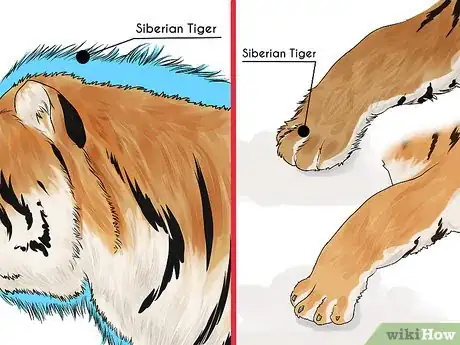This article was co-authored by wikiHow Staff. Our trained team of editors and researchers validate articles for accuracy and comprehensiveness. wikiHow's Content Management Team carefully monitors the work from our editorial staff to ensure that each article is backed by trusted research and meets our high quality standards.
There are 9 references cited in this article, which can be found at the bottom of the page.
This article has been viewed 41,224 times.
Learn more...
Not all tigers are born equal. In fact, there are five different subspecies of tigers that survive today. One of the most famous of these is the Siberian Tiger, which is also known as Amur tiger. At a glance the Siberian tiger might look like its relatives, but upon a closer look there are subtle differences that can help you pick it out in a crowd.
Steps
Judging from Appearance
-
1Look for long, thick fur. Because Siberian tigers live in colder climates than other tiger subspecies, they have considerably thicker coats. Most other tigers will have a very thin layer of fur close to their body. Siberian tigers, in contrast, will look a bit puffy because of their longer fur.[1]
- Because of their colder environment, Siberian tigers will even have thick fur on their paws.
- Because the other differences between tigers are subtle, the fur length is often the best way to distinguish a Siberian tiger from other subspecies.
-
2Look for a mane. Siberian tigers unique in that they have manes. Their manes are not as long or as distinctive as those of a lion; however, to keep themselves warm, they do have slightly longer fur around their neck. This might give the appearance that their necks are larger and puffier than those of other tigers.Advertisement
-
3Look for a tiger with fewer and lighter stripes. Each individual tiger has its own unique pattern of stripes, but there are also differences between subspecies. Siberian tigers have brown, dark, and vertical stripes covering their body, including their legs. They have fewer, more narrow, and lighter stripes than many other subspecies. Whereas other types of tigers have black stripes, Siberian tigers have dark brown stripes.[2]
- Although stripes differ from one subspecies to another, these are sometimes too subtle for anything but well-trained eye to recognize. The fact that each individual tiger has different stripe patterns also complicates the matter.
- Tigers are the only wild cats with stripes. Their stripes act as camouflage allowing them to closely stalk their prey within being seen.
-
4Look for lighter colors. Although the differences can be subtle, Siberian tigers tend to have a slightly less vibrant orange fur. It will be a lighter color than that of other subspecies. Similarly, the stripes of Siberian tigers are dark brown, rather than jet black.[3]
-
5Look for the biggest cat around. Siberian tigers are the largest of all the tiger subspecies. The average Siberian tiger is about 11 feet long, with a tail about 3 feet long. They can weigh as much as 700 lb.[4]
- Living in northern regions calls for colder climates and thus a demand for a larger body which is easier to keep warm. Large animals lose body heat slower than smaller ones. As the mean temperature of an environment decreases, the body size of warm-blooded animal species or subspecies tends to increase (this concept is known as Bergmann's rule).
-
6
Judging from Location
-
1Ask yourself if it is cold enough for a Siberian tiger. If you have encountered a tiger in the wild, then you can use your location to help determine whether the cat is Siberian tiger. Most tigers prefer warm weather climates. Siberian tigers, however live in the cold. This rule, however, does not apply to tigers in captivity. Zoos will import animals from all of the world, even when the local climate is very different from the animals natural habitat.[7]
-
2Consider whether you are far enough north for a Siberian tiger. One of the defining features of the Siberian subspecies is its habitat. Siberian tigers live principally in Eastern Russia. Some do, however, venture into North Korea and northern regions of China. By contrast, the second largest tiger, the Bengal tiger, lives in Indian and South East Asia.[8]
-
3Look for mountainous woodlands. Today, Siberian tigers predominately live in remote mountainous areas. They typically prefer birch forests. In contrast, the Bengal tiger, which is of a similar size, lives in wet, tropical climates.[9]
-
4Look at the mating pattern. Unlike some other large cats, tigers are solitary. The only exception is for mating. Male and female Siberian tigers will spend a few days together when they mate. The female will then bear the cubs for approximately 103 days. After birth, the mother will care for the cubs for about 18 months.
- There is no set time of year that Siberian tigers mate. A female, however, will generally try to mate when she is around four years old.[10]
- On average, a mother Siberian tiger will birth a litter of 6 cubs. They will venture off on their own when they are old enough. Daughters will usually find territory near their mother, whereas sons will venture off further.
Community Q&A
-
QuestionAre Siberian tigers stronger than grizzly bears?
 Community Answerit depends on their weight and gender. A heavy, muscular male would probably be stronger.
Community Answerit depends on their weight and gender. A heavy, muscular male would probably be stronger. -
QuestionWhere do tigers live?
 Silver Wolf 1Community AnswerIn Southeast Asia, China, Korea, and Russia they can be found in swamps, grasslands, and rain forests.
Silver Wolf 1Community AnswerIn Southeast Asia, China, Korea, and Russia they can be found in swamps, grasslands, and rain forests. -
QuestionDo they have any diseases?
 Community AnswerThey can have diseases as with any animal, but it depends on the specific tiger.
Community AnswerThey can have diseases as with any animal, but it depends on the specific tiger.
References
- ↑ http://www.animalfactguide.com/animal-facts/siberian-tiger/
- ↑ http://www.tigers.org.za/siberian-tiger.html
- ↑ http://knowledgenuts.com/2013/11/10/the-difference-between-bengal-and-siberian-tigers/
- ↑ http://www.animalfactguide.com/animal-facts/siberian-tiger/
- ↑ http://www.tigers.org.za/siberian-tiger.html
- ↑ http://knowledgenuts.com/2013/11/10/the-difference-between-bengal-and-siberian-tigers/
- ↑ http://animals.nationalgeographic.com/animals/mammals/siberian-tiger/
- ↑ http://animals.nationalgeographic.com/animals/mammals/siberian-tiger/
- ↑ http://www.tigers-world.com/siberian-tiger/
About This Article
To identify a Siberian tiger, look for long, thick fur all over the tiger's body, since this subspecies lives in cold climates. Siberian tigers also have slightly longer fur around their necks than other tigers, and typically have brown stripes, whereas other types of tigers have black stripes. Finally, look for the contrast of a large body and short legs, since Siberian tigers are the largest of all the tiger subspecies and tend to have shorter legs than the others. To learn about other physical characteristics that make Siberians unique, read on!





































































